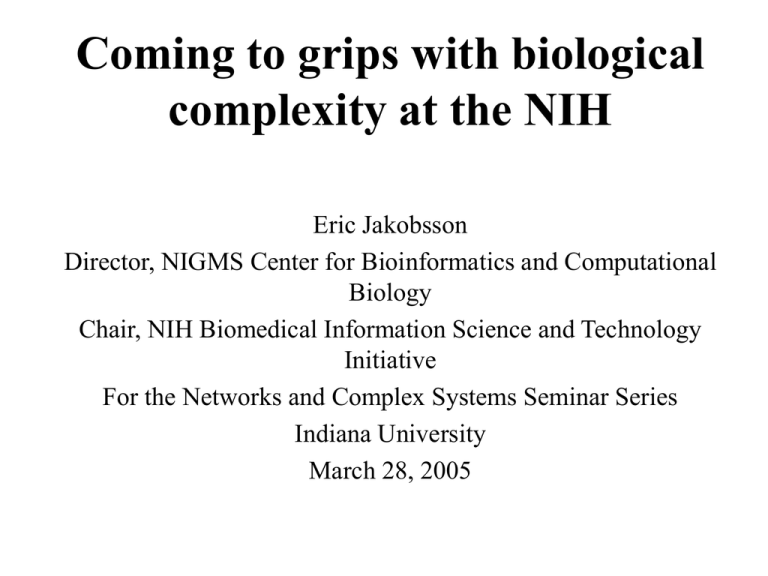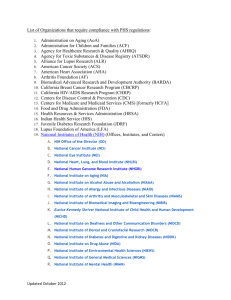Coming to grips with biological complexity at the NIH
advertisement

Coming to grips with biological complexity at the NIH Eric Jakobsson Director, NIGMS Center for Bioinformatics and Computational Biology Chair, NIH Biomedical Information Science and Technology Initiative For the Networks and Complex Systems Seminar Series Indiana University March 28, 2005 What are the elements of biological complexity? • At the molecular level, combinatorial explosion—effectively an infinite number of possible gene sequences and protein structures. (Albeit a constrained infinite number.) • At the reaction network level, the fact that single gene products are implicated in multiple reaction networks. More generally (from Tong et al, Global mapping of the yeast genetic interaction network, Science, 2-604…) What is forcing us to come to grips theoretically with biological complexity? • On the technology-push side—capabilities for highthroughput data gathering that have made us aware that biological networks have many more components than we previously surmised. • On the biology pull side---the realization that to the extent that we don’t characterize biological systems quantitatively in their full complexity, the scope and accuracy of our understanding of those systems will be compromised. (In classical experimental terms, the uncontrolled variables in the system will undermine our confidence in the conclusions we draw from the experiment or the observation. How has coming to grips with complexity made computation become critically important to advances in biology? • One can’t organize the high-throughput data into structures that are useful for generating knowledge without computers. • One can’t do the analysis, modeling, and visualization without computers. Top Ten Advances In Biomedical Computing In The Last Decade • • • • • • • 1. Sequence alignment tools. 2. Enabling Systems Biomedicine. 3. Identification of genes for disease susceptibility. 4. Computational model of HIV infection---1996 5. Tomography 6. Computer-aided Prosthetic Design. 7. Modeling electrical behavior of neurons and other electrically excitable tissue. • 8. Dissemination of bioinformatics tools on the Web -- 1993 • 9. Telemedicine. • 10. Establishment of computer networks for surveillance of disease. “Systems Biology” is an approach to understanding biological complexity. What are the elements of systems biology? • Make a parts list (based on experiment) • Make a network diagram to see how the parts are interconnected. (Inference from experiment and theory) • If you are able to do so, make a mathematical/computational model of the system that will test the completeness and correctness of your understanding and provide a guide for future experiments. Differences between systems biology and traditional cell and molecular biology • Experimental techniques in systems biology are high throughput. • Intensive computation is involved from the start in systems biology, in order to organize the data into usable computable databases. • Exploration in traditional physiology proceeds by successive cycles of hypothesis creation and hypothesis testing; data stores accumulate during these cycles. • Systems biology initially gathers data without prior hypothesis creation; hypothesis creation and testing comes during post-experiment data analysis and modeling. A simple computer experiment using prior data stores that were prehypothetically assembled. • Question: Is the plot of “Clan of the Cave Bear”, involving interbreeding between Neanderthal and anatomically modern humans, biologically plausible? • Relevant data in Genbank: Mitochondrial DNA sequences from Neanderthals, modern humans, and other mammals. • Hypothesis: Degree of relatedness of DNA may be a marker for possibility of interbreeding. • Computer experiment: Compare comparable DNA sequences from Neanderthals, modern humans other mammals including species that interbreed and those that do not. First, search Genbank for Neanderthal DNA sequences… Then, use one of the Neanderthal sequences as a BLAST probe to find its most closely related human sequence. And also use the Neanderthal sequence as blast probe to find corresponding sequences in other mammals. Next, align the sequences… And draw a phylogenetic tree… Elements of systems biology in the illustration • Made a parts list from pre-existing “comprehensive” data • Used a mathematical model to interpret functional relationships among the parts from the data • Drew a tentative conclusion but need more data What is the range of viewpoints on systems biology? Top ten challenges for computational biology in the next decade 1. 2. 3. 4. 5. 6. 7. 8. 9. 10. In silico screening of drug compounds Predicting function from structure of complex molecules at an engineering level of precision Prediction of protein structure Accurate, efficient, and comprehensive dynamic models of the spread of infectious disease Intelligent systems for mining biomedical literature Complete annotation of the genomes of selected model organisms Improved computerization of the health-care delivery system Making systems biology a reality by integrating appropriate computational tools Tuning biomedical computing software to computer hardware Promoting the use of computational biology tools in education Some important problems with biomedical computing tools are: • • • • • They are difficult to use. They are fragile. They lack interoperability of different components They suffer limitations on dissemination They often work in one program/one function mode as opposed to being part of an integrated computational environment. • There are not sufficient personnel to meet the needs for creating better biological computing tools and user environments. II. We want you if……. • You have ideas that can contribute to realizing the NIH vision. • You have the skills and motivation to implement those ideas. • The right vehicle for realizing your ideas is EITHER a large project or a small project. Looking at the NIH for support for computational projects I: General Issues • First Principle: NIH is a mission-driven agency. We support basic science (lots of it) and technology and infrastructure development (on an increasing trend line), but it all must be justifiable by a payoff down the line in improving the health of the American people. • Corollary Principle: We understand that the payoff may not be immediate, so we support work where the payoff is a decade or more in the future. It is better to present a justification for a reasonable but long-term payoff than an unrealistic short-term payoff. Looking at the NIH for support for Computational Projects II: Perspectives on the Role of Computation in Biomedical Research and Health Care Delivery • We see that non-trivial computation is critical to every aspect of our mission, from the most basic research to the efficient and effective delivery of health care in all venues. • We see the corollary: Inefficiencies, gaps, and flaws in computation are limiting the pace and scope of all aspects of our mission. • We have only gotten the message recently, so we are a work-in-progress with respect to implementing our understandings about computation in programs and practices. • We need computer scientists, computational scientists, and information technologists to be partners with NIH in getting it right. Looking at the NIH for support for computational projects III: Finding out what NIH actually funds • CRISP data base (Google “NIH CRISP” provides keyword-searchable database of all NIH-funded projects from 1972-2004 • Comprehensive access to publications by NIH grantees provided by author-searchable Pubmed literature database (Google “pubmed”) Looking at the NIH for support for computational projects IV: Building on your knowledge of what we now do to what we might support you for doing • • • First-stop (but not “one stop”) information source is the BISTI home page (Google “NIH BISTI”), button under “Funding” If you don’t find a funding announcement that fits your ideas/capabilities, but you feel you have something to contribute, don’t hesitate to send an unsolicited application. (Receipt dates February 1, June 1, and October 1 each year for new applications). Success rates for unsolicited applications are often as good as, in some cases better than, success rates for proposals submitted in response to specific funding announcements. Consult with an NIH Program Director at the concept development stage. This is easy if you are responding to a funding announcement—the right contact information is in the funding announcement. For an unsolicited application, you may need to browse through Web sites for many of the semi-autonomous 27 Institutes and Centers that comprise the NIH, as well as the NIH Roadmap site, that contains information on NIH-wide initiatives. But---NIH is a strongly interconnected community, so if you start calling program staff and the first person you call is not the right person, you will get good direction to the right person fairly quickly. Looking at the NIH for support for computational projects IV: Building on your knowledge of what we now do to what we might support you for doing (continued) • Research study sections as well as programs (Google NIH CSR), button under “Study Section Information.” • On study section targeting, consult with Program Director and/or Scientific Review Administrator (Understand that program and review functions at NIH collaborate with each other but are independently accountable. This is different from NSF, where the same individuals are responsible for both creating program and overseeing review. With respect to NIH review issues, the AUTHORITATIVE information comes from the review side) • FOLLOW THE RULES AND GUIDELINES! (Google “NIH 398” in addition to particular funding announcements.) That gives program and review staff more time to deal with your scientifically substantive concerns, because they won’t have to work around emergent procedural issues. Looking at the NIH for support for computational projects IV: Building on your knowledge of what we now do to what we might support you for doing (final) • Develop an NIH “grant journal club” (or comparable structure) at your institution where colleagues read and critique each other’s NIH grant applications and progress reports in preparation. THE BEGINNING Thank you for your attention and your commitment to building the future





